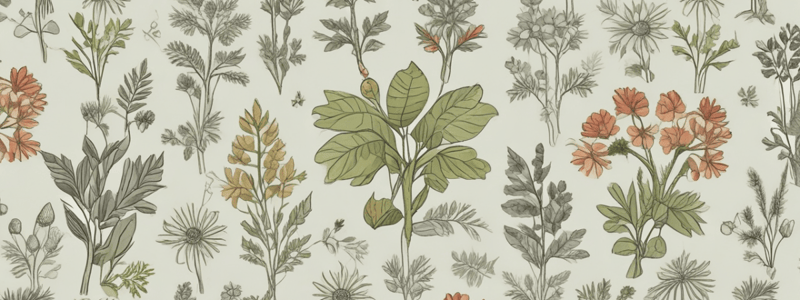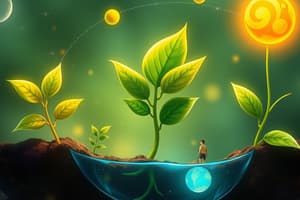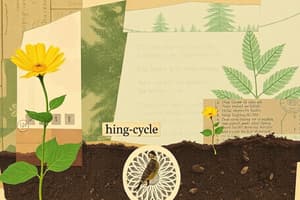Podcast
Questions and Answers
What is the main factor that determines the length of the growing season?
What is the main factor that determines the length of the growing season?
- Amount of rainfall
- Climate and elevation (correct)
- Latitude above sea level
- Daylight hours
What is the definition of a growing season?
What is the definition of a growing season?
- A period of time when plants reproduce
- A period of time when plants die
- A period of time when plants grow (correct)
- A period of time when plants are dormant
What is the purpose of counting the days when the average temperature is higher than what is required for seed germination?
What is the purpose of counting the days when the average temperature is higher than what is required for seed germination?
- To determine the amount of rainfall
- To determine the type of plant
- To determine the elevation above sea level
- To determine the growing season (correct)
In tropical and equatorial regions, how long does the growing season usually last?
In tropical and equatorial regions, how long does the growing season usually last?
What is the term for the period of time between the last killing frost in the spring to the first killing frost in fall?
What is the term for the period of time between the last killing frost in the spring to the first killing frost in fall?
What has been the result of climate change on the length of the growing season in the United States?
What has been the result of climate change on the length of the growing season in the United States?
What is the primary difference between annuals and perennials?
What is the primary difference between annuals and perennials?
What is the purpose of seeds in annual plants?
What is the purpose of seeds in annual plants?
What is a characteristic of half-hardy annual plants?
What is a characteristic of half-hardy annual plants?
What is the benefit of using native perennials in a garden?
What is the benefit of using native perennials in a garden?
What determines how long ephemerals last?
What determines how long ephemerals last?
What characteristic do half-hardy annuals have in common?
What characteristic do half-hardy annuals have in common?
What type of plant is killed by frost and unable to survive the winter?
What type of plant is killed by frost and unable to survive the winter?
What is a characteristic of perennial plants?
What is a characteristic of perennial plants?
What type of plant produces only leaves and roots during the first growing season and remains dormant until next year?
What type of plant produces only leaves and roots during the first growing season and remains dormant until next year?
Flashcards
Growing season length factor
Growing season length factor
Climate and elevation are the main factors.
Growing Season Definition
Growing Season Definition
The period when plants grow.
Counting Average Temperatures
Counting Average Temperatures
Determine the growing season length.
Growing Season in Tropics
Growing Season in Tropics
Signup and view all the flashcards
Frost-Free Days
Frost-Free Days
Signup and view all the flashcards
Climate Change Impact
Climate Change Impact
Signup and view all the flashcards
Annuals vs. Perennials
Annuals vs. Perennials
Signup and view all the flashcards
Seeds in Annual Plants
Seeds in Annual Plants
Signup and view all the flashcards
Half-Hardy Annual Charateristic
Half-Hardy Annual Charateristic
Signup and view all the flashcards
Benefit of Native Perennials
Benefit of Native Perennials
Signup and view all the flashcards
Ephemeral Lifespan Factor
Ephemeral Lifespan Factor
Signup and view all the flashcards
Half-Hardy Annual Common Trait
Half-Hardy Annual Common Trait
Signup and view all the flashcards
Plant Killed by Frost
Plant Killed by Frost
Signup and view all the flashcards
Perennial Plant Characteristic
Perennial Plant Characteristic
Signup and view all the flashcards
Plant Dormant After First Season
Plant Dormant After First Season
Signup and view all the flashcards
Study Notes
Seasons and Growing Seasons
- Seasons in a year vary by temperature, weather, amount of daylight, and rainfall
- Plants respond to these seasons in different ways
- A growing season, or frost-free season, is a period when plants can grow, limited by climate, elevation, frost days, temperature, daylight hours, and rainfall
Types of Plants
- Annual plants complete their life cycle in one growing season
- Biennial plants require two growing seasons to complete their life cycle and die
- Perennial plants live on for many years, flowering every year
- Annuals produce seeds and die after a year or two, while perennials can come back year after year without dying
Growing Season Measurement
- Measured in two ways: temperature and frost-free days
- Length of the growing season has increased in some places due to climate change
- Longer growing season can lead to invasive species and increased water needs
Annual, Biennial, and Perennial Plants
- Annuals: complete life cycle in one growing season, die after producing seeds
- Biennials: require two growing seasons, produce flowers and seeds in the second season, then die
- Perennials: live on for many years, flowering every year
Types of Annuals
- Hardy annuals: can tolerate some freezing weather and light frost
- Half-hardy annuals: tolerate cold and damp weather as well as moderate frost
- Tender annuals: cannot tolerate cool temperatures or frost
- Ephemeral annuals: have a short lifespan, often found in deserts
Perennial Cycle
- Perennial plants survive for multiple growing seasons
- Short-lived perennials may live for a few years, while long-lived perennials may live for tens or hundreds of years
- Perennials can survive extreme temperature or water changes through structures like roots, rhizoids, bulbs, or tubers
Studying That Suits You
Use AI to generate personalized quizzes and flashcards to suit your learning preferences.




